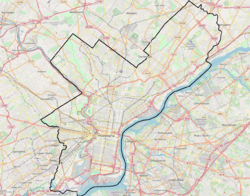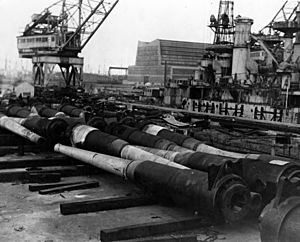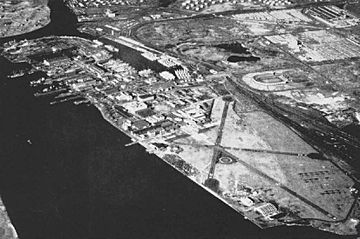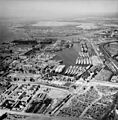Philadelphia Naval Shipyard facts for kids
Quick facts for kids The Navy Yard, Philadelphia, PA |
|
|---|---|
| Philadelphia, Pennsylvania | |
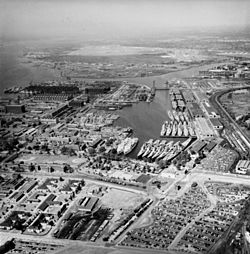
Reserve Fleet in Philadelphia in 1955
|
|
| Type | Shipyard |
| Site information | |
| Controlled by | United States Navy |
| Site history | |
| Built | 1917 (League Island Facility) |
| In use | 1801–1995 |
| Battles/wars | |
|
Philadelphia Naval Shipyard Historic District
|
|
| Location | S. Broad St. Philadelphia, Pennsylvania |
| Area | 1,200 acres (490 ha) |
| Built | 1876 |
| Architect | Robert E. Peary; Karcher & Smith |
| Architectural style | Modern Movement, Late Victorian |
| NRHP reference No. | 99001579 |
| Added to NRHP | 22 December 1999 |
|
Commandant's Quarters
|
|
|
U.S. Historic district
Contributing property |
|
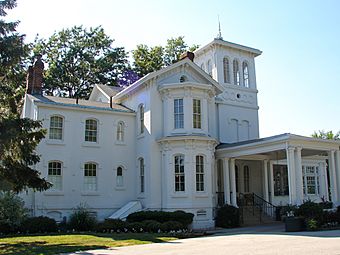 |
|
| Lua error in Module:Location_map at line 420: attempt to index field 'wikibase' (a nil value). | |
| Location | Philadelphia, Pennsylvania |
| Built | 1874 |
| Architect | US Department of the Navy |
| Architectural style | Italian Villa |
| NRHP reference No. | 76001661 |
| Added to NRHP | 3 June 1976 |
The Navy Yard in Philadelphia was once a very important place for building and fixing ships for the United States Navy. It was known as the Philadelphia Naval Shipyard. For almost 200 years, it played a big role in naval history.
Today, The Navy Yard is a large area with many different businesses. About 15,000 people work there in various industries. You can find advanced medicine factories, global fashion companies, and even a commercial shipyard.
The first navy yard in Philadelphia started in 1776 on Front Street. This was the very first naval shipyard in the United States. Later, a much bigger yard was built in 1871 on League Island. This island is where the Delaware River and Schuylkill River meet.
The U.S. Navy stopped most of its work here in the 1990s. In 2000, the city of Philadelphia took over the land. They started to develop it into what it is today. The Navy still uses a small part of the site for storing ships and for some engineering work.
Contents
The Navy Yard began as a shipyard on Philadelphia's Front Street in 1776. It became an official U.S. Navy site in 1801. From 1812 to 1865, it was a major center for building ships.
The first ship launched there was the USS Franklin. More than 50,000 people watched this exciting event. The shipyard was also the first in the world to use floating dry docks. These docks helped speed up the ship-building process.
As ships changed and became ironclad (made of iron), the old site became outdated. So, new facilities were built in 1871 on League Island. This new location was much larger and better suited for modern shipbuilding.
Workers' Rights and the Ten-Hour Day
In the early 1800s, many workers in Philadelphia wanted shorter workdays. Before 1835, workers at the Navy Yard worked from sunrise to sunset. They only had time off for breakfast.
In the summer of 1835, workers at the Philadelphia Navy Yard led a strike. They also asked President Andrew Jackson for a shorter workday. Their request was supported by their boss, Commodore James Barron.
On August 31, 1835, President Jackson ordered a ten-hour workday for the Philadelphia Navy Yard. This change started on September 3, 1835. Five years later, in 1840, President Martin Van Buren made the ten-hour day apply to all government workers doing manual labor.
Growth and World War II
The Naval Aircraft Factory was built at the League Island site in 1917. After World War I, a huge crane was added. This crane, called the League Island Crane, was built in 1919. It weighed 3,500 tons and was the largest crane in the world at that time.
Mustin Field, an airfield, opened at the Naval Aircraft Factory in 1926. It operated until 1963.
The shipyard was busiest during World War II. It employed 40,000 people. They built 53 ships and repaired 574 others. During this time, famous battleships like the New Jersey and the Wisconsin were built here.
At the Naval Laboratory, a scientist named Philip Abelson helped with the Manhattan Project. He developed a way to separate uranium-235, which was used to create the atomic bomb.
After the War and Closure
After World War II, the number of workers dropped to 12,000. In the 1960s, the Navy started hiring private companies to build new ships. The last new ship built at the yard was the command ship Blue Ridge in 1970.
The Navy Yard was officially recommended for closure in 1991. This was because of competition from foreign shipyards and less need for ships after the end of the Cold War. Despite efforts by local politicians, the yard finally closed in 1995. About 7,000 jobs were lost.
Since its closure by the Navy, the western part of the property has been leased to Aker Philadelphia Shipyard. This company builds commercial ships.
In March 2000, the City of Philadelphia became the owner of The Navy Yard. The Philadelphia Industrial Development Corporation (PIDC) now manages the area. They have a plan to turn the former industrial yard into a mixed-use campus. This means it has homes, offices, and businesses.
As of 2010, the Navy still has some activities there. These include Naval Support Activity Philadelphia and the Naval Inactive Ship Maintenance Facility (NISMF). This facility stores ships that are no longer in active service.
The Navy Yard is now home to 120 companies and 10,000 employees. It continues to grow and develop. For example, the clothing company Urban Outfitters has its headquarters here. Tastykake, a well-known bakery, also moved its factory to The Navy Yard. Other companies include GlaxoSmithKline, a pharmaceutical giant, and Aker Philadelphia Shipyard.
In 2013, a plan was announced to build more apartments for employees. The goal was to increase the number of workers at The Navy Yard to about 30,000 people. In April 2013, GlaxoSmithKline opened a large new building there.
The memorial chapel to the Four Chaplains is also located on the grounds. This chapel honors four U.S. Army chaplains who gave up their life jackets to save others during World War II.
The Athletic Base Ball Club of Philadelphia hosts an annual baseball event at the Navy Yard.
Notable Ships Built Here
Many important ships were built at The Navy Yard. Some of the most famous include:
- New Jersey
- Wisconsin: This was the last battleship for the United States Navy to have its keel laid (the first part of building the ship) on January 25, 1941.
- The last ship delivered was the LCC Blue Ridge. This ship is still in active service today.
Images for kids
See also
 In Spanish: Astillero Naval de Filadelfia para niños
In Spanish: Astillero Naval de Filadelfia para niños


